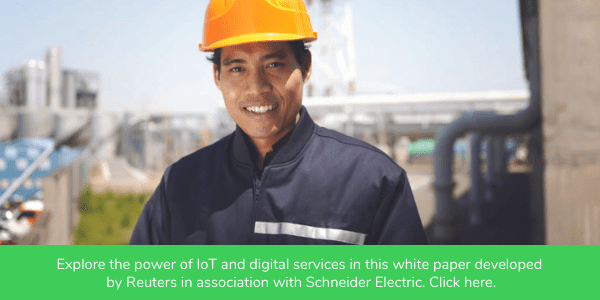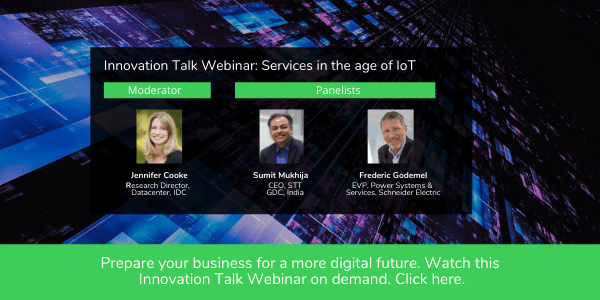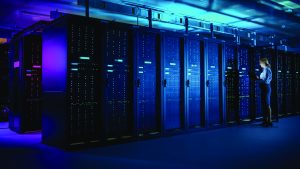When did you first hear the term “IoT?” Maybe you were already a seasoned professional with a list of career accomplishments. Maybe you were still in school. Or perhaps, like a growing number of professionals, “IoT” was simply a term you grew up with.
It doesn’t matter that IoT is visible everywhere now. What matters is why. I believe its major value is that we can use connected, digital technologies and services to fix problems that damage business performance.
Why would you accept unreliable power that puts your business at risk?
No matter which sector we look at, a couple facts are quite clear: the future will be massively more electric because it helps speed up decarbonization, and business continuity depends more and more on reliable power.
So when that supply of business lifeblood fails or causes problems, the consequences are serious. Even today, for example, the annual impact of unplanned downtime for offshore oil & gas operators is over $49 million, and as high as $88 million for the worst performers.
Or if look we at data centers, we see they average 2.4 total facility shutdowns per year, plus 10+ downtime events. At a cost of $5,600 per minute, the losses quickly become astronomical. Last, there’s the risk of fires, 25% of which are electrical in origin.
The trouble areas are pretty obvious: Problems with power and automation pose electrical risks to people and equipment, are a source of operational inefficiency, cause downtime, and place a company’s reputation or environmental goals in jeopardy.
Your first step to reduce that risk is capturing and interpreting data
I don’t believe many companies should feel comfortable with this level of risk. So the formula we prescribe at Schneider leverages the incredible power of IoT. This is how it works: We start with natively digital connected objects. Neither the digital nor the connectivity are valuable alone. But when your power and automation devices use sensors that measure equipment health and operational details to create data, are connected to communication networks that transmit those data, and use software analytics built by experts that turn those data into meaningful information – you then possess knowledge.
You can use that knowledge to protect people and assets, and free up your energy to concentrate on your main business.
Your second step is a powerful helping hand
But the power of IoT alone is not enough. You need people. So starting from the power of digital equipment, the next step adds human support. These are the traditional maintenance teams and field service experts, which are now augmented with new digital services to unlock a spectrum of benefits covering the full lifecycle of operations, from power to process.
We break those benefits into four categories:
Safety: Connected digital technology and services protect people and assets. For example, many companies are deploying augmented reality tools that allow safe, contactless maintenance of their electrical equipment in the field.
Efficiency: There are many types of efficiency, including not only energy efficiency but also operational efficiency. To get the most out of every hour of employee time, nothing beats connected digital equipment and services. Automated alerts, for example, can notify operators about trouble areas in real time, which means you spend less time and money locating and diagnosing the problem.
Resilience: Reliable power and automation keeps processes online, so well-maintained equipment is a must. I do not believe that calendar-based maintenance is the best strategy for ensuring uptime. Connected digital equipment and services let you upgrade your maintenance strategy. By using condition-based monitoring instead, companies anticipate technical problems and prevent failures before they occur, so reliability goes up and shutdowns become rare.
Sustainability: Global, national, and internal company targets increasingly focus on sustainability. Increasing energy efficiency and reducing CO2 emissions improve a company’s green credentials, while digital energy monitoring and management tools and services are the key to progress follow up. And when your power is connected, these data are at your doorstep, ready to share!
Join me at Innovation Summit 2021 to explore the power of data combined with services expertise
Connect to our Expert Learning Session with Jon Guidroz leading Energy and Sustainability Partners Strategy at Microsoft and Asif Mashhadi leading the operations of our certified EcoXpert Danway where we discuss how companies can accelerate the focus on their core business. Register now so you don’t miss it!
Look at the results of uniting connected equipment and services
Look at some examples of meaningful business results coming from services enabled by the power of IoT.
Analysts and businesses have more insights on unified IoT + Services
IoT is here to stay and its impacts can be huge – none more impressive than the transformative effect on services and the value these IoT-powered services bring to businesses today.
“Our digital journey has been a very long and fulfilled one…overall it has helped us deliver very stringent uptime SLA requirements across our facilities and increase our agility in responding to the business requirements as well.” Sumit Mukhija, CEO, STT GDC India
“Companies are not always aligned – they need a common goal and strategy. Sometimes it takes a neutral third party such as a service expert to accomplish this.” Jennifer Cooke, Research Director, Datacenter Management, IDC
Want to learn more?
I recently hosted Jennifer Cooke, IDC analyst, and Sumit Mukhija, CEO of STT GDC India – a market leader in India for colocation services with the largest footprint of data centers – to talk about the impact of digital and IoT on services:
Read some of my other articles below:
- Sustainability in Action: How ArcelorMittal Saves 170 Metric Tons of CO2
- Strength through Partnership: Spotlight on Panel Builders’ Future
- The Demand Side Needs a Boost – and Other Key Learnings from Reuters Energy Transition Europe
- Fighting Power Outages with FLISR: How it Works
- How Can Regulations Reduce F-gas in Power Networks?




